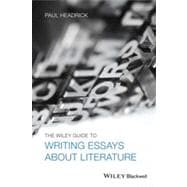This outstanding practical guide to writing analytical essays on literature develops interpretive skills through focused exercises and modeled examples. The program is tailored to meet the specific needs of beginning undergraduates.
- Features unique, detailed guidance on paragraph structure
- Includes sample essays throughout to model each stage of the essay-writing process
- Focused exercises develop the techniques outlined in each chapter
- Dedicated checklists enable quick, accurate assessment by teachers and students
- Enhanced glossary with advice on usage added to core definitions








